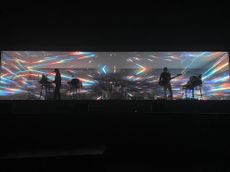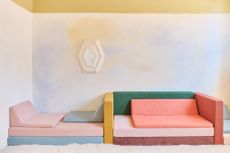Marion Vignal on curating sensation-oriented experiences in 20th century French interiors at Maison Bernard
Marion Vignal's non-profit Genius Loci seeks to discover new insights and reflections on heritage through artistic site specific experiences

This summer, the bubble architecture of the 1970s Maison Bernard, designed by Antti Lovag on the French Riviera, was illuminated by sound, dance, ceramics, sculpture and design pieces. From bedspreads to benches, each were carefully crafted and curated in response to the organic, ecological and extrovert spirit of the house. In a world full of distractions, the exhibition was specially designed to connect visitors to a moment in time; intimate viewings were accompanied by story-telling guides framing architectural history alongside contemporary issues, with no photography allowed for a focused and meditative journey..

Xavier Veilhan at Maison Bernard © Yves Gellie
This sensation-oriented atmosphere was set by Genius Loci, a French non-profit initiative that curates multi-disciplinary exhibitions in masterpieces of modern architecture seeking to discover the ‘spirit’ of a place and forge links between heritage and today. Since 2021, founder Marion Vignal, an art historian, author and curator based in Paris, has manifested the concept in and around the city at Gio Ponti’s Villa L'Ange Volant; an Auguste Perret-designed apartment; Atelier Ozenfant by Le Corbusier and Pierre Jeanneret; and a Ricardo Bofill apartment in Noisy-le-Grand, with the belief that immersive installations can be responsive, grounding and bring new meaning to space
Marion Vignal on setting up the French non-profit Genius Loci

Venia Dimitrakopoulou at Maison Bernard
Wallpaper*: How and why did Genius Loci begin?
Marion Vignal : Inspired by the Bauhaus movement, I have always considered everything to be ‘art’, from a tiny object to a piece of architecture, I never apply a hierarchy to typology or medium. I’ve never formally studied architecture, so my approach to it has always been emotional and narrative-led, and during a visit to a 1930s house near Milan, I began to think about my role as a curator and how art could help visitors to understand a place from the inside. The concept of Genius Loci is to elevate the spirit of place through an ephemeral experience of sound, smell and the elements, to tell a story and activate the past and future like a piece of literature or theatre. The architecture is the stage and the characters are the artworks; they function with purpose together, bringing opportunities to artists and keeping architecture alive and visible.

Safia Hijos at Maison Bernard
W*: The exhibition at Maison Bernard was a poignant moment of reflection on the past 50 years of progress in environmental awareness and construction innovation, which were highlighted by some of the works. What draws you to the interiors of the 20th century?
MV: I have always been attracted to buildings of the 20th century, although I am interested in other periods of architecture too. I could imagine Genius Loci taking place in an 18th century building, but never a 21st century building because the space needs time to develop a soul and the generational layers of life. What first appealed to me about functionalist interiors is that there is space to welcome in imagination. The first edition took place at Gio Ponti’s Villa L'Ange Volant, which represented the evolution of his work from neoclassical to modern. While there is a painting on the ceiling in the living room, otherwise there are these great volumes where we could place sculptures and objects to reveal the curves, light, perspective of the space, to make the architecture visible.

Studio GGSV at Maison Bernard
W*: Maison Bernard is full of shapes, niches and levels, shelves, planters and hammocks. There's so many layers for the eye to compress, it was actually quite a relief not to be able to take photographs.
MV: Antti Lovag was very egocentric, I’m not sure he wanted any other artists in the house. He wanted to plan everything, including where objects could be placed. It is certainly a total artwork, yet at the same time the interior offers so many opportunities for display. Even, for instance, on the building itself, where a rooftop performance happened with dancers intuitively finding their way up small sets of stairs and vanishing into a sunken rooftop solarium that previously I had no idea existed. The house was inspired by the shapes of the human body, so it was essential to present the artistic medium of the body.

DANCE PARC © César Vayssié
The first 30 minutes of the performance were slow and silent, against the sounds of the sea, the birds and nature. Some people found it too much, but I think it was radical, to really challenge people to focus on an artistic proposal, the architecture and the narrative. The owner told us from the beginning she didn’t want any photos, and we agreed that this would protect and preserve the experience for the visitors. It’s an energetic space, very emotional and sensitive. It’s an architecture that sharpens your consciousness and makes you feel more alive.
Wallpaper* Newsletter
Receive our daily digest of inspiration, escapism and design stories from around the world direct to your inbox.

David Logan at Maison Bernard
W*: How do you personally live with art, design and space?
MV: I don't define myself as an art collector, because I'm not necessarily interested in materiality. I think I don't need to own artworks to live with because my life is artistic. I have surrendered to art, but more in an immaterial way through books, visits and connections. Sometimes I buy artworks, but it’s very personal, like an unconscious projection. Yet overall I don't like to live with lots of objects, I enjoy the void in order to maintain a mental freedom. I’m eclectic in aesthetic and minimalist, sometimes to the extreme. If I do buy art, I constrain myself to only buying female artists. I think being a collector is about having an adventure with art and always staying intellectually involved.

Antoine Poncet at Maison Bernard
Harriet Thorpe is a writer, journalist and editor covering architecture, design and culture, with particular interest in sustainability, 20th-century architecture and community. After studying History of Art at the School of Oriental and African Studies (SOAS) and Journalism at City University in London, she developed her interest in architecture working at Wallpaper* magazine and today contributes to Wallpaper*, The World of Interiors and Icon magazine, amongst other titles. She is author of The Sustainable City (2022, Hoxton Mini Press), a book about sustainable architecture in London, and the Modern Cambridge Map (2023, Blue Crow Media), a map of 20th-century architecture in Cambridge, the city where she grew up.
-
 Three new coffee makers for a contemporary brew, from a casual cup to a full-on branded espresso
Three new coffee makers for a contemporary brew, from a casual cup to a full-on branded espressoThree new coffee makers, from AeroPress, Jura and Porsche x La Marzocco, range from the defiantly manual to the bells and whistles of a traditional countertop espresso machine
By Jonathan Bell Published
-
 Don't miss Luxembourg's retro-futuristic lab pavilion in Venice
Don't miss Luxembourg's retro-futuristic lab pavilion in VeniceAs the Venice Biennale enters its last few weeks, catch 'A Comparative Dialogue Act' at the Luxembourg Pavilion
By Amah-Rose Abrams Published
-
 A Berlin park atop an office building offers a new model of urban landscaping
A Berlin park atop an office building offers a new model of urban landscapingA Berlin park and office space by Grüntuch Ernst Architeken offer a symbiotic relationship between urban design and green living materials
By Michael Webb Published
-
 Pierre Jeanneret’s Chandigarh furniture meets South Asian diasporic art in an unusual London exhibition
Pierre Jeanneret’s Chandigarh furniture meets South Asian diasporic art in an unusual London exhibitionRajan Bijlani opens a show combining Pierre Jeanneret furniture for the Indian city of Chandigarh with works for sale by six artists of South Asian origin – in his own London townhouse
By Dal Chodha Published
-
 A new exhibition looks at preparing for a post-apocalyptic landscape (and other catastrophes)
A new exhibition looks at preparing for a post-apocalyptic landscape (and other catastrophes)‘We Will Survive' at Mudac in Lausanne, introduces us to the ‘prepper movement’, and demonstrates that we are a resilient species. Or we are doing our utmost to be as prepared as is humanly possible for disasters of all scales
By Hugo Macdonald Published
-
 Politics, oil crises and abortion rights infiltrate the optimistic 1970s interiors of Villa Benkemoun
Politics, oil crises and abortion rights infiltrate the optimistic 1970s interiors of Villa BenkemounFor the 50th anniversary of Villa Benkemoun in Arles, a new exhibition critically explores the year of 1974 through contemporary and historic artworks that antagonise the optimism of its design
By Harriet Thorpe Published
-
 Ora ïto expresses his design language in an artistic alphabet he calls Grammatology
Ora ïto expresses his design language in an artistic alphabet he calls GrammatologyAbstraction and functionalism inform two exhibitions from the maverick multidisciplinary French designer Ora ïto at St-Paul de Vence and Marseille
By Harriet Thorpe Published
-
 First look: French designers Marie & Alexandre move in for the summer to Marseille's Cité Radieuse
First look: French designers Marie & Alexandre move in for the summer to Marseille's Cité RadieuseEscaping The Olympics in Paris momentarily, we head to Le Corbusier’s celebrated housing block in Marseille, where Apartment 50’s exhibition concept returns for another immersive show of collectible design.
By Harriet Thorpe Published
-
 ‘Air Play Moon Safari’ is an audio-visual, retro-futuristic experience
‘Air Play Moon Safari’ is an audio-visual, retro-futuristic experienceWith the ‘Air Play Moon Safari’ tour in full swing across Europe, the USA and Mexico for the rest of 2024, we explore the design of the French band's White Box stage
By Simon Mills Published
-
 Design Parade is the South of France's annual design extravaganza
Design Parade is the South of France's annual design extravaganzaIf you're heading to the South of France this summer, don't miss Design Parade Hyeres & Toulon 2024, the annual creative extravaganza spotlighting emerging talent in historical locations
By Harriet Thorpe Published
-
 Rajan Bijlani’s design collection is inspired by a mission to conserve the Chandigarh legacy
Rajan Bijlani’s design collection is inspired by a mission to conserve the Chandigarh legacyBritish-Indian collector Rajan Bijlani’s collection of unseen Le Corbusier and Jeanneret Chandigarh furniture collection is given new life
By Maghie Ghali Published